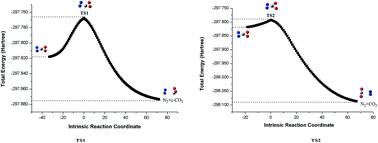Bicyclic CN2O2 as a high-energy density material: promising or not?
Abstract
Besides their fundamental importance, compounds containing C, N and O have great potential as so-called “high-energy density materials” (HEDMs). Due to their explosive nature, HEDMs usually have great difficulty in laboratory synthesis and characterization. Thus, reliably finding a HEDM candidate with good kinetic stability (i.e., rate-determining barrier is above 20 kcal mol−1) in computation has proven to be a key base for the subsequent experimental study, as well as being documented by two recent examples, i.e., diazirinone ([C,N2,O]-A, Angew. Chem., Int. Ed., 2011, 50, 1720) and nitryl cyanide ([C,N2,O2]-B, Angew. Chem., Int. Ed., 2014, 53, 6893). What is the next synthetic target for molecular HEDMs? Having been predicted to possess both large exothermicity (190 kcal mol−1) and a large decomposition barrier to N2 + CO2 (29 kcal mol−1) at the CCSD(T)/TZ2P//MP2/6-31G(d) level (J. Phys. Chem., 1996, 100, 19840), C with a bicyclic [C,N2,O2] structure appears to well deserve a synthetic trial for HEDMs. In this work, by re-evaluating the stability of C, we located a new rate-determining transition state for decomposition (TS2). With TS2, a significantly reduced decomposition barrier was arrived at, i.e., 11.6–13.0 kcal mol−1 at the G3B3, CBS-QB3, G4, W1BD and CCSD(T)_CBS//B3LYP/aug-cc-pVTZ composite energy calculated levels using a restricted wave function. Strikingly, TS2 possesses a significant open-shell feature and the barrier was further reduced to be 6.9 kcal mol−1 at the UCCSD(T)_CBS//UB3LYP/aug-cc-pVTZ level. Thus, the bicyclic isomer C is unlikely to be a molecular HEDM, though its spectroscopic detection could still be feasible. Finally, the ring-opening stability of the c-CO2 moiety in the present [C,N2,O2]-C largely contrasts with that in the well-known methyldioxirane, demonstrating a different influence on the complexation to c-CO2.


 Please wait while we load your content...
Please wait while we load your content...